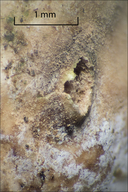|
|
click photo for larger file

Tulostoma brumale
Winter Stalkball
|
Photographer: Dr. Amadej Trnkoczy
ID: 0000 0000 1222 0273 (2022-12-05)Copyright © 2022 Dr. Amadej Trnkoczy
|
|
INFORMATION PROVIDED WITH THE PHOTO
|
date of photo Nov 9, 2022
latitude 45.31861 longitude 13.62120
View on Google Maps.
location
2 km north from village Tar, next to a dead-end dirt road leading toward Mirna river (Istria, Croatia)family
Agaricaceae
notes Slo.: zimski puhar - syn.: Lycoperdon pediculatum Bull., Tulostoma lacerum Pers., Tulostoma mammosum P. Micheli ex Fr., Tulostoma pedunculatum (L.) Czern. - Habitat: small patches of grassland among bushes in garrigue, covered by mosses (about 30% coverage); sandy, skeletal, calcareous ground; dry, sunny place; exposed to direct rain, average precipitations ~ 1.000 mm/year, average temperature 10-12 deg C, elevation 70 m (230 feet), Sub-Mediterranean phytogeographical region. - Substratum: sandy, calcareous soil. - Comments (pertain to pictures in the Flicks album Tulostoma brumale): Taxa of the genus Tulostoma are easy to recognize. The habit of stalked puffballs is so characteristic. However, determinations on species level are many times a completely different story. How many species are in the genus and their taxonomy depend on whom you are willing to listen. The number of taxa varies enormously from a few tens to well over hundred approaching two hundred. Index-Fungorum cites over 180 taxon names in the genus, MycoBank over 250. Every larger new molecular study changes the situation and usually creates new species. Some experts state that only a few of all these taxa can be reliably determined on the basis of morphology only. Microscopy is inevitable. Some professionals even state that reliable determination on basis of a single or a few specimens is not possible and that one has to study populations. - Anyway, this find seems to be Tulostoma brumale. This species is also one of the most common. Many morphological and microscopic traits of this find correspond well to descriptions in the literature and yet I am not completely sure that the determination is correct. Probably too dark stripe and too scaly, questionable exoperidium nature, quite 'feeble' reddish-brown halo around peristome and quite often not distinctly tubular peristome projections make me worried. - Description: Average peridium diameter (dry state): 8.3 mm, height 6.5 mm (Q=1.3, n= 5); exoperidium seems to be composed from white hypha layer, often interwoven with ground debris, which remains at the bottom of the spore-ball after the stalk grows; membranous endoperidium ocher-brown, like thin parchment; peridium apex generally with projecting peristome, but some fruit bodies almost without projections; brown collar around peristome many times poorly visible; gleba dark ocher-brown with reddish tint; capillitium flexible, thick walled, with strongly and abruptly widening of the capillitial septa, septa without clamps, capillitium here and there covered with fine grains (crystals ?); stalk cylindrical, in most cases quite dark brown coarsely scaly and longitudinally furrowed when dry; average height 23 mm, average stalk diameter 2.1 mm; stalk slightly but consistently tapering toward the base (on exsiccata); Spores globose to sub-globose, coarsely warty. Dimensions: (4.1) 4.4 – 5.1 (5.4) × (3.9) 4.1 – 4.8 (5.1) µm, Q = 1 – 1.2 (1.,3); N = 40; Me = 4.7 × 4.4 µm; Qe = 1.1. Oympus CH20, NEA 100x/1.25, magnification 1.000 x, oil (spores); NEA 40x/0.65, magnification 400x (hypha), NEA 10x/0.25, magnification 100x (hypha); in 5% KOH, dry material. AmScope MA500 digital camera. Novex, Zoom Stereo RZ_Range, Holland (peristome, gleba, septa, stalk surface). - Ref.: (1) Personal communication with Mr. Bojan Rot, www. gobenabovskem.si (2) K. Rusevska, F. de Diego Calonge, , M. Karadelev, M. P. Martín, Fungal DNA barcode (ITS nrDNA) reveals more diversity than expected in Tulostoma from Macedonia, Turk J Bot, (2019), 43: 102-115. (3) https://www.first-nature.com/fungi/tulostoma-brumale.php (accessed Nov 30. 2022) (4) T. Lӕssøe, J.H. Petersen, Fungi of temperate Europe, Vol. 2., Princeton University Press (2019), p 1244. (5) G.J. Krieglsteiner (Hrsg.), Die Grosspilze Baden-Württembergs, Band 2., Ulmer (2000), p 180. (6) J. Breitenbach, F. Kraenzlin, Eds., Fungi of Switzerland, Vol.2. Verlag Mykologia (1986), p 396. (7) Jeppson, M., Altés, A., Moreno, G., Nilsson, RH., Loarce, Y., de Bustos, A., Larsson, E. Unexpected high species, diversity among European stalked puffballs – a contribution to the phylogeny and taxonomy of the genus Tulostoma (Agaricales). MycoKeys (2017) 21: 33–88. https://doi.org/10.3897/mycokeys.21.12176camera Sony ILCE6000 / Carl Zeiss Vario-Tessar E 16-70 mm/f4 on Novex Zoom Stereo RZ Range
contributor's ID # Bot_1497/2022_DSC01744 photo category: Fungi - fungi
|
MORE INFORMATION ABOUT THIS FUNGUS
|
| common names
Winter Stalkball (photographer)
View all photos in CalPhotos of Tulostoma brumale Check Google Images for Tulostoma brumale |
|
The photographer's identification Tulostoma brumale has not been reviewed. Click here to review or comment on the identification. |
|
Using this photo The thumbnail photo (128x192 pixels) on this page may be freely used for personal or academic purposes without prior permission under the Fair Use provisions of US copyright law as long as the photo is clearly credited with © 2022 Dr. Amadej Trnkoczy.
For other uses, or if you have questions, contact Dr. Amadej Trnkoczy amadej.trnkoczy[AT]siol.net. (Replace the [AT] with the @ symbol before sending an email.) |
|
|
